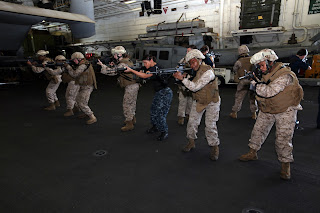 |
| U.S. Marines Birthplace |
The U.S. Marine Corps celebrates its birthday on November 10, 1775, the day the Second Continental Congress passed the Continental Marine Act of 1775, ordering, “That two battalions of Marines be raised…” The Continental Marines disbanded in 1783, and was formally reestablished in 1798. The first Marines enlisted at Tun Tavern in Philadelphia, which is considered the birthplace of the Marine Corps. mentalfloss
Tun Tavern is where the Marine Corps held its first recruitment drive during the american Revolution.
In the year 1685, Samuel Carpenter built a huge "brew house" in Philadelphia. He located this tavern on the waterfront at the corner of Water Street and Tun Alley. The old English word tun means a cask, barrel, or keg of beer. So, with his new beer tavern on Tun Alley, Carpenter elected to christen the new waterfront brewery with a logical name, Tun Tavern. In 1756 Col. Benjamin Franklin organized the Pennsylvania Militia. He used Tun Tavern as a gathering place to recruit a regiment of soldiers to go into battle against the Indian uprisings that were plaguing the American colonies. George Washington, Thomas Jefferson, and the Continental Congress later met in Tun Tavern as the American colonies prepared for independence from the English Crown. On November 10, 1775, the Continental Congress commissioned Samuel Nicholas to raise two Battalions of Marines. That very day, Nicholas set up shop in Tun Tavern. He appointed Robert Mullan, then the proprietor of the tavern, to the job of chief Marine Recruiter -- serving, of course, from his place of business at Tun Tavern. Prospective recruits flocked to the tavern, lured by (1) cold beer and (2) the opportunity to serve in the new Corps of Marines. So, yes, the U.S. Marine Corps was indeed born in Tun Tavern. Needless to say, both the Marine Corps and the tavern thrived during this new relationship. USMC Heritage
Tun Tavern burned down in 1781, near the end of the American Revolution.
 |
| All Things Masonic |
The National Museum of the Marine Corps in Quantico, Virginia contains a Tun Tavern-themed restaurant with a lunch menu, alcoholic beverages, and bread pudding. The decor of the tun tavern restaurant features a large painting depicting famous Marines from the founding of the corps to the present day.
 |
| Roaming the Planet:: The museum’s Tun Tavern captures the warmth of the original and features food inspired by the Colonial era. |
There is even a Tun Tavern Marines Motorcycle Riding Club.
 |
| Tun Tavern Marines |
But then again:
From the book, The Marine Corps Story, by J.Robert Moskin, 1992, Little, Brown and Company"...The two battalions were never raised; but onNovember 28, the Congress commissioned thirty-twoyear old Capt. Samuel Nicholas, a PhiladelphiaQuaker, and innkeeper and a blacksmith's son, asthe first Marine officer. A hundred volunteers,recruited in Rhode Island, arrived atPhiladelphia by December 5...probably signed upin Robert Mullan's Tun Tavern."
And, from the book, The United States Marines AHistory, by Edwin Howard Simmons. 1998, NavalInstitute Press"...According to legend, the recruiting redezvouswas Tun Tavern, but it is more likely that it wasthe Conestoga Wagon, a tavern owned by theNicholas family on Market Street between Fourthand Fifth Streets."
And, from the book, Marine Corps Book Of Lists,Albert A. Nofi, 1999, Combined Publishing"...Eight Hoary Old Marine Corps Legends That AreNot True. 1. The first Marine recruiting stationwas established in Tun Tavern, in Philadelphia,the proprietor of which was so adept at securingrecruits, by liberally plying them with drink,that he was made a captain in the Corps. Alas for"romance," the story is untrue. It probably gotits start from the fact that Samuel Nicholas,effectively the first Marine Commandant, actuallydid own a tavern in Philadelphia, the ConestogaWagon, which apparently served as hisheadquarters for a time. However the owner of theTun Tavern did become a Marine officer, about ayear after the creation of the Corps, whichprobably gave rise to the legend. Legends and Myths Of The Corps



















;10080504.jpg)





